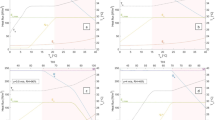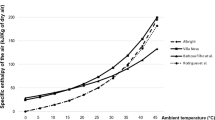Abstract
The combined temperature-humidity heat stress is estimated in farm animals by indices derived of an index based on human thermal comfort sensation. The latter index consists of temperature and humidity measures that sum to form the temperature-humidity index (THI). The hitherto unknown relative contribution of temperature and humidity to the THI was examined. A temperature-humidity data set (temperature 20–42 °C and relative humidity 10–70 %) was used to assess by regression procedures the relative weights of temperature and humidity in the variance of THI values produced by six commonly used heat stress indices. The temperature (Ta) effect was predominant (0.82–0.95 of variance) and humidity accounted for only 0.05 to 0.12 of THI variance, half of the variance encountered in animal responses to variable humidity heat stress. Significant difference in THI values was found between indices in the relative weights of temperature and humidity. As in THI indices, temperature and humidity are expressed in different physical units, their sum has no physical attributes, and empirical evaluations assess THI relation to animal responses. A sensible heat THI was created, in which at higher temperatures humidity reaches 0.25 of sensible heat, similarly to evaporative heat loss span in heat stressed animals. It relates to ambient temperature-humidity similarly to present THI; its values are similar to other THI but greater at higher humidity. In warm conditions, mean animal responses are similar in both indices. The higher sensitivity to humidity makes this index preferable for warm-humid conditions.

Similar content being viewed by others
References
Arkin H, Kimmel E, Berman A, Broday D (1991) Heat-transfer properties of dry and wet furs of dairy-cows. Trans ASAE 34:2550–2558
Berman A (1968) Nychthemeral and seasonal patterns of thermoregulation in cattle. Austr J Agric Res 19:181–189
Berman A (2005) Estimates of heat stress relief needs for Holstein dairy cows. J Anim Sci 83:1377–1384
Berman A, Meltzer A (1973) Critical temperatures in lactating dairy cattle: a new approach to an old problem. Int J Biometeorol 17:167–176
Bianca W (1962) Relative importance of dry- and wet-bulb temperatures in causing heat stress in cattle. Nature 195(4838):251–252
Bohmanova J, Misztal I, Cole JB (2007) Temperature-humidity indices as indicators of milk production losses due to heat stress. J Dairy Sci 90:1947–1956
Cargill BF, Stewart RE (1966) Effect of humidity on total heat and total vapor dissipation of Holstein cows. Trans ASAE 9:702–712
da Silva RG, Morais EF, Guilhermino MM (2007) Evaluation of thermal stress indexes for dairy cows in tropical regions. Braz J Anim Sci 36:1192–1198
Dikmen S, Hansen PJ (2009) Is the temperature-humidity index the best indicator of heat stress in lactating dairy cows in a subtropical environment? J Dairy Sci 92:109–116
Epstein Y, Moran DS (2006) Thermal comfort and the heat stress indices. Ind Health 44:388–398
Hahn GL, Gaughan JB, Mader TL, Eigenberg RA (2009) Thermal indices and their applications for livestock environments. In: DeShazer JA (ed) Livestock energetics and thermal environmental management. ASBE., pp 113–130
Ingraham RH, Gillette DD, Wagner WD (1974) Relationship of temperature and humidity to conception rate of Holstein cows in subtropical climate. J Dairy Sci 57:476–481
Jendritzky G, de Dear R, Havenith G (2012) UTCI—why another thermal index? Int J Biometeorol 56:421–428
Lopes LB, Oliveira AC, Leite RC (2009) Environmental influence on reproductive performance of Bos taurus cows and crossbred animals B. taurus X B. indicus. Rev Brasil Med Vet 31:213–215
Maia ASC, DaSilva RG, Loureiro CMB (2005a) Respiratory heat loss of Holstein cows in a tropical environment. Intl J Biometeorol 49:332–336
Maia ASC, daSilva RG, Loureiro CMB (2005b) Sensible and latent heat loss from the body surface of Holstein cows in a tropical environment. Int J Biometeorol 50:17–22
Matzarakis A, Rutz F, Mayer H (2007) Modelling radiation fluxes in simple and complex environments—application of the RayMan model. Int J Biometeorol 51:323–334
Maust LE, McDowell RE, Hooven NW (1972) Effect of summer weather on performance of Holstein cows in three stages of lactation. J Dairy Sci 55:1133–1139
McLean JA (1963) Partition of insensible losses of body weight and heat from cattle under various climatic conditions. J Physiol Lond 167:427–447
Mclean JA (1972) Calculation of heat production from open-circuit calorimetric measurements. Brit J Nutr 27:597
Monteith JL (1973) Principles of environmental physics. Contemporary Biology, 1973. Edward Arnold Ltd, London, UK
Nabenishi H, Ohta H, Nishimoto T, Morita T, Ashizawa K, Tsuzuki Y (2011) Effect of the temperature-humidity index on body temperature and conception rate of lactating dairy cows in southwestern Japan. J Reprod Dev 57:450–456
Oliveira JL, Esmay ML (1982) Systems model analysis of hot weather housing for livestock. Trans ASAE 25:1355–1359
Ravagnolo O, Misztal I (2002) Effect of heat stress on nonreturn rate in Holstein cows: genetic analyses. J Dairy Sci 85(11):3092–3100
SAS User’s Guide (2004) Statistics (2004) Version 9.2 edition. SAS Institute Inc, Cary, NC US
Stevens DG (1981) A model of respiratory vapor loss in Holstein dairy cattle. Trans ASAE 24:151–153
Thom EC (1959) The discomfort index. Weatherwise 12:57–59
Author information
Authors and Affiliations
Corresponding author
Rights and permissions
About this article
Cite this article
Berman, A., Horovitz, T., Kaim, M. et al. A comparison of THI indices leads to a sensible heat-based heat stress index for shaded cattle that aligns temperature and humidity stress. Int J Biometeorol 60, 1453–1462 (2016). https://doi.org/10.1007/s00484-016-1136-9
Received:
Revised:
Accepted:
Published:
Issue Date:
DOI: https://doi.org/10.1007/s00484-016-1136-9




